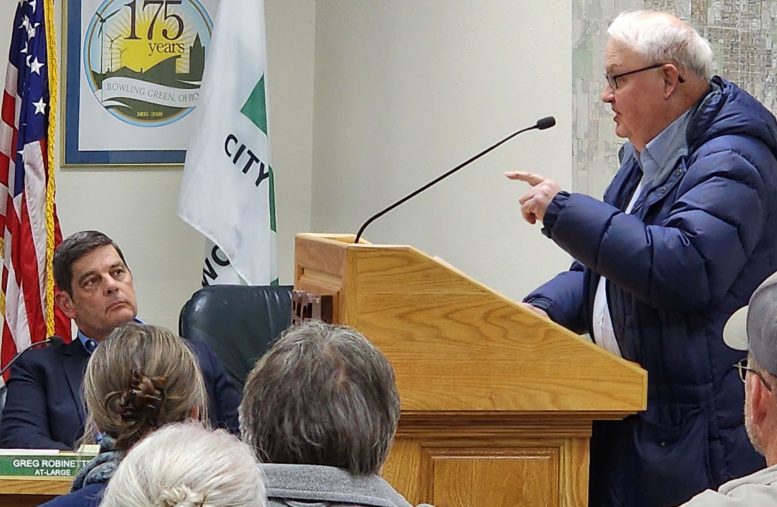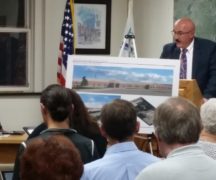By JAN LARSON McLAUGHLIN
BG Independent News
After months of being whittled away, the controversial Pedestrian Residential zoning surrounding Bowling Green’s downtown will only allow two permitted commercial uses – professional offices and bed & breakfast operations.
Relentless citizen opposition led to all other commercial uses – like corner stores or taverns – being scratched off the permitted and conditional uses. Acting City Council President Rachel Phipps reported the changes to homeowners again packing the council chambers Monday evening.
While pleased with those changes, the residents remained troubled by the zoning change that would allow duplexes in their older neighborhoods that are already brimming with rental housing.
“Thank you for removing many of the commercial uses,” homeowner Rose Drain said to council. But that was followed up with a request that council next remove two-unit dwellings and additional dwelling unit language from the new PR zoning district.
Others agreed.
“You’ve heard it before. We don’t want more duplexes than we already have,” said Anesa Miller.
Miller suggested that duplexes be allowed in the new housing development proposed at the southwest corner of Brim and Newton roads.
“You have an opportunity to make a real difference,” she said. “Without imposing all the burden on the historic areas.”
Later in the meeting, it was stated by City Council that if approved, the new housing subdivision would be zoned R-2, which in the new zoning code will allow duplexes.
Council member Greg Robinette reminded residents that amendments can be introduced to the zoning ordinance as it progresses through council hearings.
And council member Bill Herald announced that he intends to introduce an amendment that would remove duplexes from permitted uses in the Pedestrian Residential zoned areas.
Council will continue to hear from residents on the zoning changes at the next two council meetings, then will hold a public hearing on the zoning code update on May 17, at 6 p.m., in the Veterans Building in City Park.
On Monday, John Sampen, vice chairperson of the city’s Historic Preservation Commission, said it is unfair to put the Pedestrian Residential zoning where residents clearly don’t want it – citing 600 signatures on a petition opposing the zoning change.
Even to create an historic preservation district, all the property owners have to be surveyed first, Sampen said. That courtesy should be extended in the zoning code update, he said.
Homeowner Steve Ricard voiced the exasperation of several present Monday, who feel many of their zoning questions have gone ignored.
“We’re still frustrated that many of the questions are still unanswered,” he said.
The historic neighborhoods around the downtown already have many non-conforming duplexes and multi-dwelling units. Why must more be hoisted on the same areas, Ricard asked.
“Why shouldn’t it be implemented in other neighborhoods?” he said.
Ricard asked City Council to hold another public meeting on May 1 specifically designed for give-and-take between citizens and council on the zoning issue.
“We’re looking for dialogue here,” he said.
David Neuendorff expressed concern that the zoning changes would destroy the basic historic housing stock in the city. The area surrounding the downtown is already very walkable, he said, and the city has no lack of commercial development areas, including the “essentially abandoned mall.”
Rather than encouraging duplexes in the historic neighborhoods, Neuendorff suggested that the city encourage property owners to turn divided houses back into single-family homes. There is already plenty of student housing in apartment complexes, he added.
“You have a potential of having a walkable community with families living there” in the neighborhoods surrounding the downtown, Neuendorff said.
Rose Drain also voiced concern about the lack of building design standards for the proposed Pedestrian Residential district, which encompasses about 104 residential blocks of the city surrounding downtown. Other areas in the zoning code have multiple pages devoted to standards for structures, facade and design.
“These neighborhoods are historic with single family homes built in the late 1800s through the 1930s and 1940s,” Drain said. “A stated intent of the code – to promote the preservation of historic resources – is being overlooked in the fine print.”
Drain offered the assistance of the Save Our BG Neighborhoods group in writing the standards.
“New construction in these neighborhoods needs to respect what is already here and fit well with the historic existing homes,” she said.





